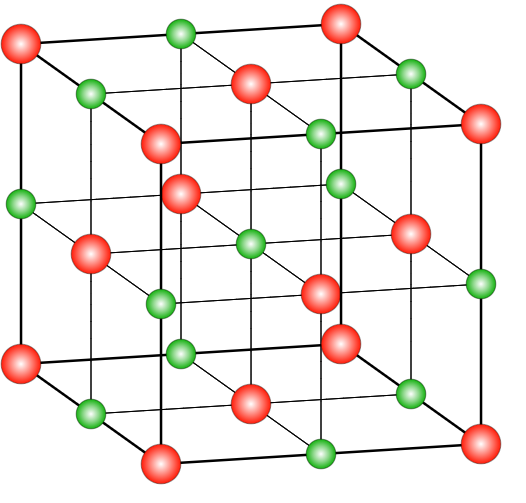
The crystalline structure of \[NaCl\] is
A. Hexagonal close packing
B. Face-centred cubic
C. square planar
D. body-centred cubic
Answer
577.5k+ views
Hint: A unit cell that has a lattice point at every face centre in addition to the lattice point at every corner is called a face-centred cubic unit cell. In the case of \[NaCl\], the ratio of chloride to the ratio of sodium ions is 1:1.
Complete step by step answer:
In the case of \[NaCl\], the structure is a rock salt type structure with coordination number being in a ratio of 6:6 which means that there are 6 chloride ions present on the 6 faces of the face centred cubic system and 6 Na+ ions occupy the octahedral voids in the lattice system. There are many compounds that have a similar structure as the sodium chloride structure. The ratio of radius range of anions and cations ranges between 225-414 nm. Those structures which have a similar structure to that of \[NaCl\] include different alkyl halides, oxides of different metals, etc. In the case of a face-centred cubic system, the coordination number will be 12 and the distance between the two nearest atoms will be $\dfrac{{a\sqrt 2 }}{2}$ . The relation between the radius and side length in such a system is $r = \frac{a}{{2\sqrt 2 }}$ .
Thus, the correct option is (B) Face-centred cubic.

where red spheres represent $Cl^-$ and green ones are for $Na^+$
Note:
In a face centred cubic system, along the face diagonal, all the atoms touch each other and the length of the face diagonal is $a\sqrt 2 $ . The number of atoms per unit cell in FCC lattice is 4 and the packing efficiency is 74% with void space of 26%.
Complete step by step answer:
In the case of \[NaCl\], the structure is a rock salt type structure with coordination number being in a ratio of 6:6 which means that there are 6 chloride ions present on the 6 faces of the face centred cubic system and 6 Na+ ions occupy the octahedral voids in the lattice system. There are many compounds that have a similar structure as the sodium chloride structure. The ratio of radius range of anions and cations ranges between 225-414 nm. Those structures which have a similar structure to that of \[NaCl\] include different alkyl halides, oxides of different metals, etc. In the case of a face-centred cubic system, the coordination number will be 12 and the distance between the two nearest atoms will be $\dfrac{{a\sqrt 2 }}{2}$ . The relation between the radius and side length in such a system is $r = \frac{a}{{2\sqrt 2 }}$ .
Thus, the correct option is (B) Face-centred cubic.

where red spheres represent $Cl^-$ and green ones are for $Na^+$
Note:
In a face centred cubic system, along the face diagonal, all the atoms touch each other and the length of the face diagonal is $a\sqrt 2 $ . The number of atoms per unit cell in FCC lattice is 4 and the packing efficiency is 74% with void space of 26%.
Recently Updated Pages
Master Class 12 English: Engaging Questions & Answers for Success

Master Class 12 Business Studies: Engaging Questions & Answers for Success

Master Class 12 Economics: Engaging Questions & Answers for Success

Master Class 12 Social Science: Engaging Questions & Answers for Success

Master Class 12 Maths: Engaging Questions & Answers for Success

Master Class 12 Chemistry: Engaging Questions & Answers for Success

Trending doubts
What are the major means of transport Explain each class 12 social science CBSE

Which are the Top 10 Largest Countries of the World?

Draw a labelled sketch of the human eye class 12 physics CBSE

Explain sex determination in humans with line diag class 12 biology CBSE

The pH of the pancreatic juice is A 64 B 86 C 120 D class 12 biology CBSE

Explain sex determination in humans with the help of class 12 biology CBSE




